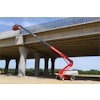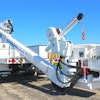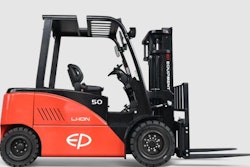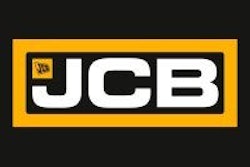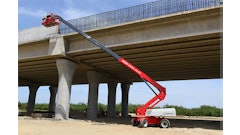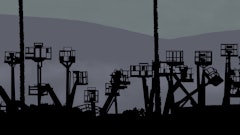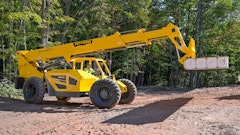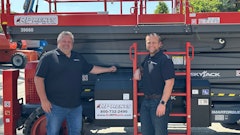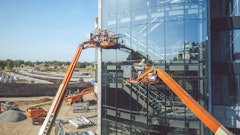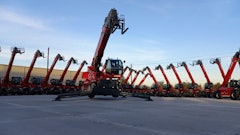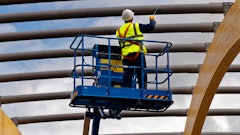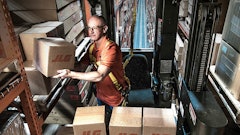There was a time when the United Rental operation in Lakeside, CA, had as many as 20 straight-mast forklifts available to rent. Now contractors can choose from just four.
“We’ve been selling them out of the fleet because we weren’t getting very good utilization from them anymore,” says Todd Moir, manager of the rental center. The change has a direct correlation to the growing popularity of the compact telehandler. “If someone wants an 8,000-lb. capacity machine, a forward reach forklift (compact telehandler) isn’t that much bigger, but it can do so much more than a straight-mast forklift.”
The United Rental store rented its first compact telehandler in 1998 as a way to take advantage of the growing residential housing market. “We’re an aerial rental company and we needed some way to become involved with the housing projects,” Moir explains.
“There are so many new homes being built in southern California, and we weren’t getting any of that market because we didn’t have the equipment contractors wanted. We decided to take on the Terex compact telehandler line so we could get more of the residential construction market.”
Just six years later, rentals of compact telehandlers have increased to the point where Moir maintains a fleet of about 100 units.
A compact multi-tasker
Versatility is one reason for the compact telehandler’s popularity. “With its compact nature, maneuverability is better than a full-size telehandler so it can work around close lot lines and among trees,” says Martin Miller, VersaHandler product manager at Bobcat.
“And it’s compact like a straight-mast forklift, but it has greater reach.”
“A straight-mast forklift does a good job of taking a load up to a specified height and placing it close to the front of the machine,” adds Jay Barth at JCB Inc. “But a compact telehandler can take a load up to the same height or higher, extend the boom and place the load precisely where you want it.”
A compact telehandler also has an advantage in unloading trucks in tight spaces because it is able to unload from one side. “You can park the truck to one side of the jobsite and you don’t have to work from both sides, or reposition the truck,” says Barth.
“You can extend the boom and go across to the other side of the truck, lift the load up and move it to wherever you want.”
Versatility is further expanded because of the compact telehandler’s ability to function as a tool carrier, utilizing various attachments such as buckets, sweepers or truss booms. Many manufacturers also incorporate auxiliary hydraulics to handle specialized equipment such as grapples or clamps.
“You can only put forks on a forklift, then it’s the end of the story,” says Miller. “With most compact telehandlers, you can attach a bucket to move material, load trucks, set trusses, etc.”
Because of the attachments, a compact telehandler can also do much of the same work as a skid-steer loader, says Beau Anderson at Terex Construction. “Contractors can switch between forks and buckets, giving this machine the ability to do the work of two,” he says. “And with four-wheel steering, maneuverability even over rough terrain is excellent.”
“Basically, the only thing missing when compared to a skid-steer loader is the 360º turn on a dime steering,” adds Barth. “But if you don’t require it, you won’t miss it.”
The ability to do more than one job can allow contractors to get by with fewer machines. “A compact telehandler can move dirt and dig so a contractor doesn’t have to bring in specialized machines such as wheel loaders or backhoes,” says Barth.
This is especially beneficial for smaller contractors or those just getting into the business, notes Miller. “When you’re starting a business, you don’t have a lot of capital for multiple pieces of equipment, so you’re looking for something that can do more than one job,” he says. “With a compact telehandler, you can lift and reach, backfill around foundations, clear lots, load and unload trucks and do multiple bucket applications.”
Rick Olson finds that his Bobcat VersaHandler compact telehandler has eliminated the need to purchase a skid steer or a straight-mast forklift. He and his brother, Robert, build single-family homes in the Inver Grove Heights area in Minnesota. Initially, they purchased one VersaHandler, but now are renting a second one that they intend to buy soon.
Each machine is used for a variety of jobs, including transporting material, unloading trucks and setting trusses. They are also used during siding installation and, when equipped with a bucket, to put in driveways and clean up jobsites.
“We don’t have a forklift or a skid-steer loader,” Olson says. “These compact telehandlers replace those machines. They are small enough to do most jobs of a skid steer, and they can fit into a regular size garage and move around well. With them, we can reach about 32 ft. off the ground (24 ft. to the platform) so we can reach two-story homes, even those with walkout basements.”
Weigh costs vs. the added benefits
While compact telehandlers have cut into the straight-mast forklift market, Barth explains that there’s still a place for the latter.
“There are still situations where a straight-mast forklift does a good job,” he says. “It’s a rugged piece of equipment and is a good choice for moving very heavy loads of palletized material where you have room to adequately move around. And they’re usually less expensive than a compact telehandler. Depending on the manufacturer, comparing capacity to capacity at the same lift height, the list price can be about 15% to 20% more for a compact telehandler.”
The more expensive price tag can be attributed to additional moving parts and a more versatile steering system typically offering three steering modes. “But it’s the things that make it more expensive that also make it more versatile,” Barth continues. “They can pay off for you, but they don’t come free.”
Moir agrees, noting that rental rates at his United Rental center reflect the increased machine costs. Typical rates for an 8,000-lb. forklift will be about $1,300 to $1,500 a month, whereas a compact telehandler will be about $2,400 to $2,700 a month.
“But these machines are just so versatile,” Moir adds. “Contractors will use them for everything from moving underground pipes on the very first part of the job to setting trusses or joists toward the end of the job.”
